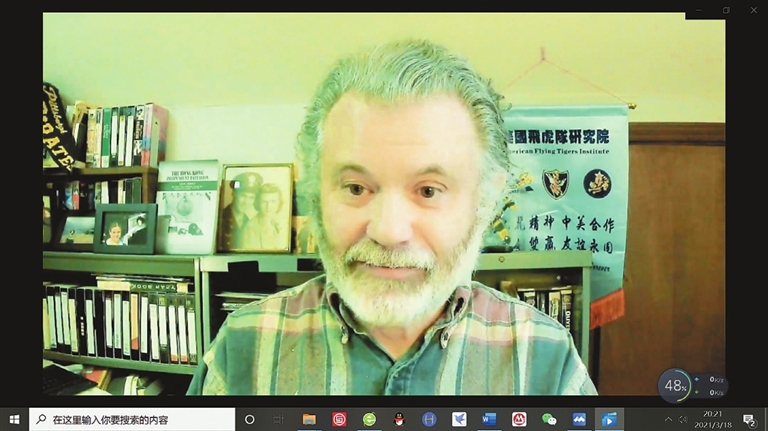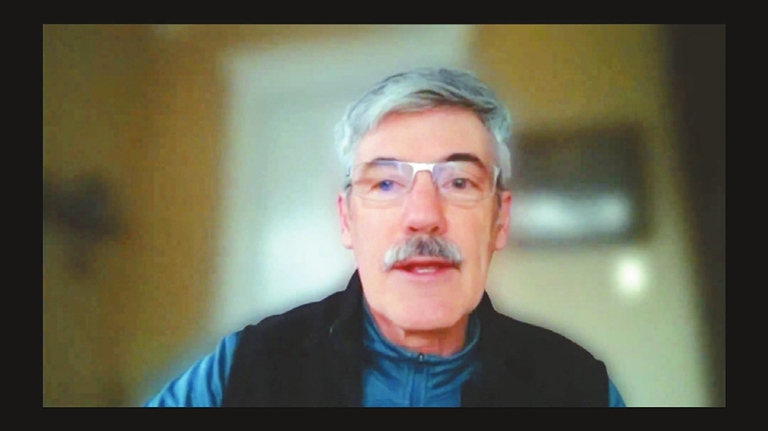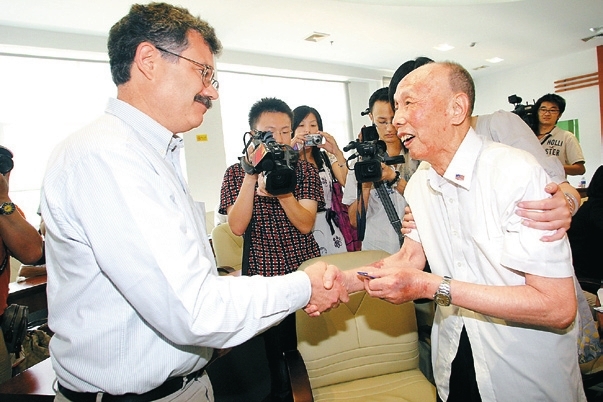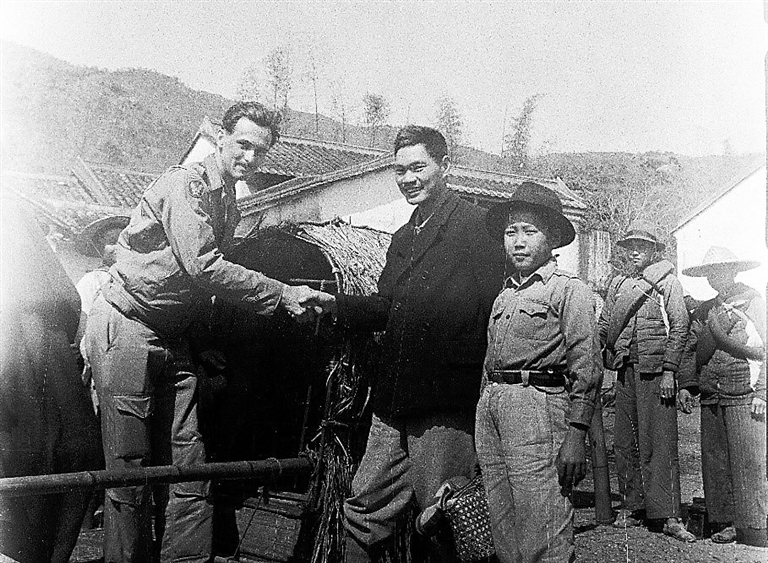




Lin Min linmin67@hotmail.com WHEN “Flying Tiger” Lieutenant Donald W. Kerr was rescued by the Dongjiang Column guerillas during World War II to a safe place in what would become Shenzhen decades later, he unknowingly started his family’s bond with the city that has lasted for 77 years. And that bond still shows no sign of withering. His second son, David Kerr, said Thursday during a video interview with Shenzhen Daily that he is planning to visit Shenzhen again as soon as the COVID-19 pandemic dies down. David and his family traveled to Shenzhen in 2008 to say thank you to the veterans of the CPC-led Dongjiang Column, also known as East River Column, who saved his father, a U.S. air force pilot helping China fight Japanese invaders. Lt. Kerr was grateful for his association with the Chinese people — first in the air as fellow pilots and later on the ground as courageous rescuers, according to his journal. David took great pains to locate the veterans and their families to fulfill a lifelong dream of his father: a journey of gratitude. Epic rescue On Feb. 11, 1944, Lt. Kerr was on a mission to bomb Hong Kong’s Kai-Tak airport, which had become an airbase of the Japanese invaders. After he shot down a Japanese plane, three enemy planes attacked. Kerr’s aircraft was hit and caught fire. He had to eject from the burning aircraft, according to Lt. Kerr’s memoir. The memoir is believed to have been written in the days immediately following the pilot’s rescue. It was first discovered by his family in 1982, five years after his death at the age of 62. While parachuting, Lt. Kerr, then in his 30s, lost hope when he saw Japanese soldiers cheering on the ground, waiting to capture him. Fortunately, the wind blew him to a hill in Sha Tin and he was saved by a 14-year-old Dongjiang Column soldier, Li Shi. Li and other guerillas hid the injured pilot in various places, including a cave in a mountain where he spent nearly two weeks protected by five guerrillas around the clock. Upon hearing of Lt. Kerr’s situation, Zeng Sheng, commander of the column, decided to bring him out of the Japanese-occupied areas at whatever cost. The commander organized the audacious rescue that involved attacks on the Kai-Tak airport and other enemy strongholds to distract the Japanese forces who were desperately searching for Lt. Kerr. Lt. Kerr arrived in Nan’ao on a boat and for a few days stayed in Tuyang, where the column was headquartered, before embarking on a 10-day journey to his base in Guilin, Guangxi. Lt. Kerr’s rescue was chronicled by “Take Me Home,” a documentary movie that premiered in 2015. It was also featured in several books. SZ’s frequent guest Since the 2008 journey of gratitude, David Kerr has visited Shenzhen twice a year — except in 2020 when the pandemic made international travel almost impossible. David’s elder brother, Andy, also visited Shenzhen several times. “I had the privilege of becoming friends with Deng Bin’s (one of the guerillas) family and the families of other old soldiers and their families in Shenzhen. I have visited with them almost every year since 2008,” David told Shenzhen Daily. “In 2015, my brother, Andy Kerr, and I worked with Deng Bin’s son, Deng Liping, to create a video that he sponsored commemorating his father’s work in the East River Column during the war, including the rescue of Lt. Kerr,” he added. David said whenever he was in Shenzhen, he would meet Jiang Shan, son of Li Siu-wah who was very important to the rescue of his father. “As often as possible, I meet with Chen Xiaoyan, the daughter of a small boy who escorted my father through much of his escape,” he said. On several occasions David also met Zeng Kaiping, the third son of Commander Zeng. “There are many ties between the East River family and the Kerr family. I am very happy to have such an extended family,” David said. Unfortunately almost all the old soldiers have died, including almost all veterans he met in 2008, he said. “So both the East River descendants and the Kerr family descendants feel important to keep that memory alive, to remember that time, 75 [77] years ago, when our parents got together and did a very great thing to help defeat our common enemy,” David added. Generational warmth David’s elder brother, Andy, also traveled to Shenzhen in 2009, 2014 and 2015. “It was fascinating to meet these people (the rescuers) and their children and grandchildren,” Andy told Shenzhen Daily on Friday via video link. Andy’s wife and daughters also came with him in 2015, meeting many people in “celebratory” atmospheres. Today the Kerr family still has strong gratitude towards the guerillas. Andy said he recently learned of the complex issues regarding planning and executing the rescue, such as keeping the operation secret. “There were so many levels of difficulties they (the guerillas) had to overcome,” he said, adding the Kerr family is “eternally grateful” for the rescuers. Andy said the descendants of his father’s rescuers seemed to remember Lt. Kerr’s warm attitude towards Chinese people. “His attitude and warmth to Chinese people in general was passed down … and there was warmth that we felt from the relatives and descendants that was very noticeable. And I went away very touched after that,” Andy recalled of his family’s meeting with the Dongjiang descendants. SZ, a showcase for China David sent a photo of his father thanking Commander Zeng to Shenzhen Daily via email. “The photo was taken in Shenzhen. I am happy that my father felt safe when he got to Shenzhen, and I am happy to see how dynamic the city is today. The people of Shenzhen should be very proud of how the city has grown and prospered.” He said his father would be “very surprised and very happy” if Lt. Kerr were able to see Shenzhen today. “When he came to Shenzhen in 1944, it was a collection of small fishing villages … maybe about 8,000 people. And now 20 million. A real showcase for China.” Shenzhen was the first Chinese city David visited. As an employee of Lenovo U.S. in 2005, he arrived in Shenzhen from Hong Kong at night. When he woke up the next morning, he saw “a huge city spreading in front of me.” Shenzhen is “a city absolutely full of life, everyone very optimistic about the future,” he said. “Everyone driving forward, to make the city great, and to make their careers great.” More exchange urged In David’s opinion, American people and Chinese people need to visit each other. “People in the United States who’ve not been to China have an impression from television shows and movies from a hundred years ago: everyone bicycles and works in fields. And I tell them, China is not what you are going to expect. You need to come to China and see for yourself the great progress the country has made,” David said. “I think the Chinese people and American people have great respect to each other, and I really want to encourage that American people visit Chinese people, and Chinese people come here and visit. When you show your country to somebody else you really start to understand how many commonalities [there are] between the Chinese people and American people.” In his opinion, international cooperation — which led to Lt. Kerr’s military service in China and his rescue — remains important today. “From a personal perspective, I always tell people: remember how cooperation has helped us in the past and let’s make Shenzhen a world city, where you bring in the strength of all countries, put them together and become a world-class city. I really think Shenzhen has become that in amazingly fast time,” he added. | 
